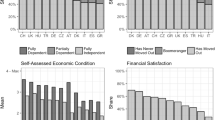Abstract
One of the preconditions for participation in urban development, or any economic development, may well be a proper diet. Yet little is understood about the demand function for nutrition—particularly that of minorities. This study uses regression analysis applied to field research data in an effort to yield insight into the demand for nutrition of urban deprived single Mexican-American youth ages 14 to 21 years old. The regression equation includes both economic and noneconomic dependent variables. The results indicate that there exists a synergistic relationship between economic and noneconomic variables influencing the demand for nutrition. The facts that the economic variable income had no relationship to diet led the writer to conclude there are two types of poverty, internalized and external, and that the preponderance of the literature contains data and reasoning taken from the external group where there apparently is a relationship between income and diet. Internalized poverty means a psychological inability to provide for the future, i.e., incapable of engaging in activities that are spaced over time. External poverty means a temporary situational poverty directly connected to the prevaling economic conditions.
Similar content being viewed by others
References
Barlow, P. “The Effects of Malaria Eradication,”American Economic Proceedings; 130–148, 1967.
Bawden, D. L. “The Neglected Human Factor,”American Journal of Agricultural Economics, 55: 879–887, December 1973.
Berg, A.,The Nutrition Factor, Washington, D. C., The Brookings Institution, 1973.
Bixby, L. E. “Some Effects of Low Income on Children and Their Families,” inAmerican Society Inc., edited by Maurice Zeitlin (Markham Publishing Co., Chicago) 161–171, 1970.
Carter, James P., Member of President Nixon's Citizens Board of Inquiry into Hunger and Malnutrition. Paper given at Houston Medical Forum, Houston, Texas, June 1974.
Cullumbine, H. “The Health of Tropical People: A Survey in Ceylon,”The Lancet, pp. 1090–1092, May 1963. This method is widely accepted.
Down, Anthony.Urban Problems and Prospects. Chicago: Markham Publishing Co., 1970.
Guthrie, H. A., Madden, J. P., Yoder, M. D. and Koontz, H. P. “Effects of USDA Commodity Distribution Program on Nutritive Intake,”Journal of the American Dietetic Association, C1: 287–292, September 1972.
Hanock, Giora, “An Economic Analysis of Earnings and Schooling,”Journal of Human Resources, 1; 310–331, Summer, 1967. Mushkin, S. J., “Health as an Investment,”Journal of Political Economy; 120–157, October 1962. Schultz, T. W.,The Economic Value of Education, New York: Columbia University Press, 1963.
Hearings Before the Select Committee on Nutrition and Human Needs of the United States Senate, 90th Congress Second Session and 91st Congress First Session on Nutrition and Human Needs. Washington, D. C., January, 1969. See Part 3 — The National Nutrition Survey.
Leverton, R. M., “Nutritional Levels in Rural United States: New Approaches Needed,”The Quality of Rural Living (Workshop Proceedings). National Academy of Sciences, Washington, D. C., 29–41, 1971.
Lewis, O., “The Culture of Poverty,”Scientific American, Vol. 215, pp. 19–25, October 1966.
Lowe, C. V., “Nutrition, Child Care, and Public Policy,” Hearings Before the Select Committee on Nutrition and Human Needs of the United States Senate, 91st Congress, Washington, D. C.; 1096–1100, 1969.
Madden, J. P. and Yoder, M. D., “Food Stamps and Commodity Distribution in Rural Areas of Central Pennsylvania,” Department of Agricultural Economics and Rural Sociology. Pennsylvania State University, University Park, Pennsylvania. Bulletin 780, June 1970.
Myers, M. L. and Stare, F. J., “A Nutrition Study of School Children in a Depressed Urban District,” Hearings Before the Select Committee on Nutrition and Human Needs of the United States Senate, 99th Congress, Washington, D. C., pp. 1069–1071, 1969.
Newhouse, J. P., “Determinants of Days Lost from Work Due to Sickness,” Articles in Herbert Klarman'sEmpirical Studies in Health Economics, Johns Hopkins Press; London, p. 25, 1965.
Orshanky, M., “Counting the Poor: Another Look at the Poverty Profile,”Social Security Bulletin, 28: pp. 3–29, September 1965.
Pond, M. A., “Interrelationship of Poverty and Disease,”Public Health Reports, Vol. 76, No. 11, p. 971, November 1961.
Santos, M., “Industrial Cities Eat Better,”F. A. O. Review, 4: p. 31, 1971.
Schaefer, A. E., “Malnutrition at Home and Abroad,” Hearings Before the Select Committee on Nutrition and Human Needs of the United States Senate, 99th Congress, Washington, D.C., pp. 870–871, 1969.
Stigler, G. J., “The Cost of Subsistence,”Journal of Farm Economics, 27: pp. 303–314, May 1945.
U. S. Department of Agriculture. Household Food Consumption Survey, 1955. Dietary Evaluation of Food Used in Households in the U.S. Report No. 16, November 1961. See also Food Consumption and Dietary Levels of Households of Different Size, the U.S. by Regions, Report No. 17, January 1963.
Walter, J. P., “Internal and External Poverty and Nutritional Determinants of Urban Slum Youth,”The Ecology of Food and Nutrition; 2: pp. 3–10.
Walter, J. P., “Two Poverties and Many Hungry Indians: An Economic and Social Study of Nutrition,”American Journal of Economics and Sociology, 33: pp. 33–44, January 1974.
Author information
Authors and Affiliations
Additional information
Thanks to T. W. Friedman for programming work. The usual disclaimer applies.
Rights and permissions
About this article
Cite this article
Walter, J.P. Nutrition and human capital formation: The Urban deprived Mexican American youth. Ann Reg Sci 9, 91–102 (1975). https://doi.org/10.1007/BF01287428
Issue Date:
DOI: https://doi.org/10.1007/BF01287428




